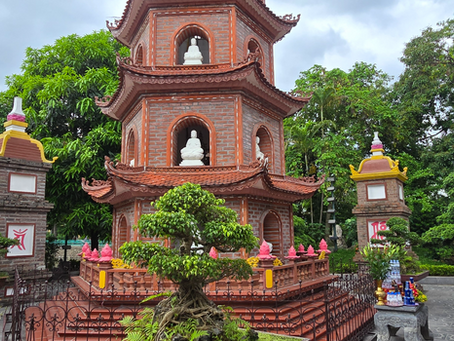top of page

GLOBAL SHANANIGANS

Search


Ubud Water Palace
Built in honour of its namesake Saraswati, the Hindu goddess of knowledge, music, art, wisdom and learning, Pura Taman Saraswati is a graceful water temple nestled in the heart of downtown Ubud. This sacred site blends spiritual reverence with classical Balinese aesthetics, offering a peaceful retreat just steps away from the town’s busy centre.
Shannon


Lempuyang Temple - Heaven's Gate
Standing proudly at 1175 metres above sea level, on the peak of Mount Lempuyang, this ancient temple complex is among Bali’s oldest and most revered, believed to predate most Hindu temples on the island. Although there is some confusion about the site’s exact age, the establishment of temples here stretches back at least a millennium.
Shannon


Inside the Puputan - Bali's Bloody Resistance
The Dutch first reached Bali in 1597 while scouting new ground for conquest and profit. They left without drawing blood but they didn’t leave without a decision. Bali had been marked. For the next two centuries, the island remained untouched, not because the Dutch had lost interest, but because they were waiting for the moment it would be worth the slaughter. It wasn’t peace. It was a pause before an extermination. When they returned, the rivers would turn red.
Shannon


Ho Chi Minh Museum
The Ho Chi Minh Museum in Hanoi is more than a museum, it is a shrine to revolution, memory and sacrifice, standing as one of Vietnam’s most important monuments. It honours the man known as “Uncle Ho” while also serving as a vast archive of the struggles that shaped modern Vietnam, a place where personal biography and national trauma merge into a single, powerful narrative.
Shannon


Seven Star Park of the Immortals
Seven Star Park, located on the eastern side of Guilin, Guangxi, derives its name from the formation of seven limestone peaks arranged in the shape of the Big Dipper constellation. This celestial reference is not only a poetic nod to the stars but also deeply symbolic in Chinese cosmology, where the Big Dipper is associated with divine guidance, fate and protection.
Shannon


Bridge Between Worlds - Ngọc Sơn Temple
Tucked away on a small jade-green islet in the heart of Hanoi’s Hoàn Kiếm Lake, Ngọc Sơn Temple (“Temple of the Jade Mountain”) is a portal into Vietnam’s tangled history of war, mysticism, and legend. Ngọc Sơn Temple rose in 1841 to honour the national hero General Trần Hưng Đạo, who crushed Mongol invaders in the 13th century, and its story is woven tightly with both fact and fascinating folklore.
Shannon


Through the Mist of Thác Bạc - The Silver Waterfall of Sa Pa
Located about 13km's down a winding alpine road from Sa Pa town, the majestic Silver Waterfall thunders 200 metres down the cliffs of the Hoàng Liên Son Mountains from the headwaters of the Lo Sui Tong peak. Known to locals as "Thác Bạc" the falls are fed by glacial runoff that originate near the summit of Fansipan, the highest peak and "Roof of Indochina"
Shannon


The Temple of the Dog
Thủy Trung Tiên Temple, once known as Cẩu Nhi Temple, rests on a quiet, tree-lined island on Trúc Bạch Lake, just north of Hanoi’s West Lake. Modest in size but heavy with history, the temple dates back over 1000 years and is one of the capital’s oldest surviving spiritual sites. Few visitors realise it’s built on the remnants of a forgotten cult, one centred on the worship of a dog.
Shannon


H’Mong King Palace - Fortress of the Opium King
Deep within the misty limestone mountains of Vietnam’s northern highlands, the H’Mong Kings' Palace stands as a solemn relic of power, ambition & tribal legacy. Also known as the Vuong Family Mansion (Dinh Vua Mèo), construction commenced in 1898 under the directive of H’Mong leader Vương Chính Đức, a powerful warlord and opium King.
Shannon


The Legacy of Trấn Quốc Pagoda
With its origins stretching back over 1500 years, Trấn Quốc Pagoda holds the distinction of being the oldest Buddhist temple in the country. It was originally built around 545 AD during the reign of Emperor Lý Nam Đế, who commissioned its construction as part of a broader vision to legitimise Vietnamese sovereignty in the midst of political upheaval and resistance against Chinese rule.
Shannon


Trúc Lâm Phật Tích Bản Giốc Pagoda
Perched on the forested slopes of Phia Nham Mountain in northern Vietnam’s Cao Bằng Province, this pagoda complex is a spiritual beacon overlooking the breathtaking Bản Giốc Waterfall. Officially inaugurated in December 2014, the pagoda holds the distinction of being the first Buddhist temple built along the northern border of Vietnam.
Shannon


The Legacy of King Lê Thái Tổ
This quiet and understated shrine on the southeastern banks of Hoàn Kiếm Lake pays homage to King Lê Thái Tổ, the revered 15th-century General-turned-Emperor. He liberated Vietnam from Chinese rule and founded the Later Lê Dynasty, the country's longest ruling imperial line. Built in 1894, the Lê King Temple is a quiet portal into Vietnam’s post-colonial rebirth, layered with political significance and tales of divine destiny, rebellion and the enduring power of myth.
Shannon


Quan Thanh Temple and The Dark God of Hanoi
Perched at the edge of Hanoi’s scenic West Lake, Quán Thánh stands as one of Vietnam’s most venerable Taoist temples. Believed to have been founded during the reign of Emperor Lý Thái Tổ in the 11th century, the temple was originally built to honour Trấn Vũ, the feared & revered Taoist deity known as the “Guardian of the North".
Shannon


Meiji Shrine - A Monument to Modern Japan
Relatively young compared to many of Japan’s ancient temples and shrines, Meiji Shrine (Meiji Jingū) holds deep symbolic and national significance. Completed in 1920, it was constructed to honour the deified spirits of Emperor Meiji and his beloved consort, Empress Shōken. Emperor Meiji (1852–1912) presided over one of the most turbulent and transformative periods in Japanese history, overseeing the end of the Tokugawa shogunate and the rapid modernisation of the nation.
Shannon


Lumphini Park - Where Dragons Roam
In 1925, King Rama VI transformed a patch of Bangkok’s then quiet outskirts into a space meant for both education and recreation. Although his original vision of a museum never materialized, the area gradually became the city’s first public park. He named it Lumphini, after the birthplace of the Buddha in Nepal, symbolising a deep respect for Thai culture and heritage amid a period of rapid modernisation.
Shannon


The Killing Fields - Cambodia's Genocide
Located in the dusty outskirts of Phnom Penh lies Choeung Ek, the most infamous of Cambodia’s killing fields. Once a peaceful longan orchard, it now stands as a site of incomprehensible horror and grief. While over 300 killing fields have been identified throughout the country, Choeung Ek alone bore witness to the execution of more than 17,000 men, women and children during the Khmer Rouge regime.
Shannon


Fushimi Inari Taisha Shrine
Famous for its thousands of vivid orange torii gates, Fushimi Inari is an ancient Shinto head shrine and a designated World Heritage site, located in the southeastern part of Kyoto. Dedicated to Inari, the Shinto god of rice, prosperity and foxes, the shrine dates back to the 8th century and remains one of Japan’s most iconic spiritual landmarks
Shannon


Tianmen Mountain - Heavens Gate
Often hailed as the “Gateway to Heaven,” Tianmen Mountain stands as one of China’s most breathtaking natural marvels. Perched above the city of Zhangjiajie in Hunan Province, this majestic peak rises to 4,980 feet above sea level. From its lofty heights, visitors are rewarded with sweeping panoramic views of rolling valleys, jagged cliffs and pristine forests that have remained untouched for centuries.
Shannon


Bayon - The Temple of Faces
Built around 1190AD during the reign of the powerful King Jayavarman VII, Bayon stood at the symbolic heart of Angkor Thom, the ancient capital of the Khmer Empire. From a distance, the temple may appear as little more than a chaotic pile of stone, but step closer and it transforms into a breathtaking showcase of Khmer "baroque" architecture.
Shannon


Reed Flute Cave
The Reed Flute Cave, or Ludi Yan as it is known locally, has a fascinating history that stretches back over 1200 years, beginning during the Tang Dynasty. This 180 million year old karst cave complex, located in Guilin, has long been a symbol of natural beauty and historical significance. Its geological formations are a breathtaking testament to the slow, steady power of time, yet its human history is just as remarkable.
Shannon
bottom of page